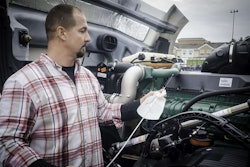 Unlike a truck maker’s comprehensive warranty, aftermarket warranties focus largely on the powertrain
Unlike a truck maker’s comprehensive warranty, aftermarket warranties focus largely on the powertrainAftermarket warranties have become popular add-ons in a used truck purchase for extending coverage beyond a factory warranty. The key difference in them versus an original equipment manufacturer’s warranty is that “OEMs typically cover many more items, many of which don’t ever fail and/or that are not expensive to replace,” says Lynn Murphy, president and chief executive officer of warranty provider Premium 2000. “Aftermarket warranties typically cover expensive game-changing repairs, ones that can bankrupt a commercial truck owner.”
Aftermarket warranties focus largely on the engine, including aftertreatment, the transmission and the rear axles, since failure along the powertrain can be expensive in parts, labor and downtime.
Most used truck buyers only have enough for a down payment, says Ted Fick, executive chairman of National Truck Protection. “The last thing they can afford is to pay for a $20,000 engine repair,” he says. “For a few hundred dollars deductible, you can prevent from being thrown into bankruptcy.”
In most cases, any truck that passes an underwriter’s certification inspection is eligible for warranty coverage. Fick says trucks older than 10 model years with more than 1 million miles would require more testing, which could include a dynamometer test. Underwriters also require an ECM download to check for known faults. “If there are issues, we ask that those be remedied before we put the warranty on that vehicle,” he says.

As with an OEM warranty, ongoing maintenance is part of keeping the aftermarket policy valid. Policyholders must document each time the truck stops for service, and those records can be used to support the warranty claim’s validity.
“Our warranty has specific maintenance requirements per the class of vehicle,” says Lindsey Stroschein, executive director of customer and retailer services for TrüNorth Warranty Plans of North America. “Regular preventive maintenance at a licensed certified facility is required in order to keep the warranty in place.”
Aftermarket warranty terms normally require the owner to keep track of PM receipts, making sure to include the VIN, date of service and mileage. If PM mandates are not met, a claim can be denied and the coverage voided, Murphy says.
“If we pull the plug on the [oil] pan, and it looks like jelly coming out of it because you haven’t been changing the oil, then we’re going to require oil change maintenance records,” says Chad Lucky, regional service director for National Truck Protection.
Stroschein says customers are required to submit their PMs to the claims department for review as part of the claim. “Only in a fleet situation approved by TrüNorth is the customer allowed to do their own maintenance,” she says. A customer with five or more trucks is considered a fleet.
Truck Master allows policyholders to perform their own maintenance. “In the rare event that we ask for maintenance records, we will even accept invoices for purchasing the materials needed if the customer performs their own maintenance,” says Jeff Dobish, the company’s president. “There are very few claims that require us to ask for maintenance records.”
When repair is needed, the only requirement of the policyholder is to use a licensed mechanic with Automotive Service Excellence certification. “There are no in-network restrictions,” Dobish says. “We want our customers to use shops they trust and are comfortable with if possible.”
Fisk says that while requiring ASE certification provides a measure of professionalism that ensures quality repairs, it also gives owners more flexibility in choosing from a broad set of dealerships and aftermarket service providers instead of limiting choices to an OEM or network provider. “Any OEM dealership is going to have ASE-certified techs,” he says. “There also are any number of independent repair shops that are largely ASE-certified.”
Stroschein says the warranty does not dictate part type or brand preference. “We are open to the repair facility using OE parts or reman, refurbished or used parts,” she says. “We need to be aware of the quality of parts going into the truck during the repair.”
Dobish says availability often dictates whether the part needs to be OEM or aftermarket. “We prefer to use OEM parts whenever possible to take advantage of the nationwide OEM warranty for the parts,” he says. “Considering the customer’s uptime is the most important factor when processing claims. We will do what is best for the customer, and they are involved in the entire process.”
The protocol for the repair process in an aftermarket warranty claim is similar to that of an OEM warranty claim. A repair facility or a customer should contact the underwriter, and claims adjustors will review the information submitted, including the repair cost estimate and diagnostics information. Some policies require a photograph of the failed part.
Adjustors “will be looking to make sure that the right parts are being used and that the repairs are being completed properly,” Dobish says. “We always want to make sure the repair facility has not overlooked any progressive damage caused by the failure.”
Once the underwriter confirms the repairs are completed properly and the customer is satisfied, payment is made. “In rare occasions, a customer will pay for a repair that is warrantable and submit the invoice and diagnostics data to us, and we will reimburse them directly for the repair,” Dobish says.
Unlike a manufacturer’s warranty, which must be purchased at the time the truck is bought, an aftermarket warranty can be added at any point. If an aftermarket warranty is purchased before the OEM warranty lapses, the inspection process for the truck takes into account the warranty service history.
“Having an OEM warranty still on your truck helps you,” Lucky says. “If you let it run out, then it hurts you. You’re going to have a little bit more tedious inspection process.”









